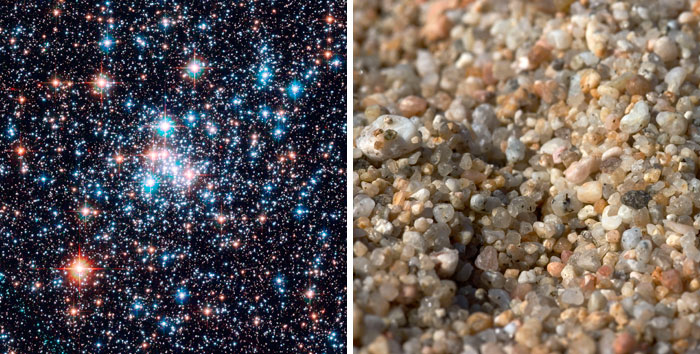
Let’s make earth be a largish grain of sand, about 1.27 mm in diameter. This gives us a scale of 10^10 or ten billion to one. Fairly easy to make calculations this way.
All in this scale:
- Distance to the moon: 40 mm, about 1.6 inches
- Distance to the sun (1 AU): 15 meters or about 50 feet.
- Distance to Jupiter: 78 m.
- Distance to Pluto: 600 m.
- One light year (9.5 trillion km): 950 km. BTW, this means light moves at 0.03 m/s.
- Distance to nearest star (4.22 LY): 4000 km.
- Distance to galactic center (26,000 LY): 25 million km.
- Distance to Andromeda galaxy (2.54 million LY): 2.4 billion km (but at this scale, still within our real-world solar system).
- Distance to the center of our Virgo supercluster (about 65 million LY): 60 billion km (deep in the Oort Cloud, in the real universe). There are probably 10 million superclusters in the observable universe, so we are still a big step away from the size!
- Distance to the edge of the observable universe (94 billion LY): 90 trillion km, almost 10 LY in the real universe.
So scaling the earth to a grain of sand, Pluto is a 10 minute walk, local stars are a plane flight away, our local group of galaxies fits in the solar system, but the edge of the universe is way past the nearest star! A freaking big place!
Edit — just for fun: Bryan Harris asked about sizes (rather than distances) in this scale:
11. Size of Jupiter: 14.3 mm (a large marble).
12. Size of HAT-P-35b (largest accurately measured exoplanet): 50–70 mm (a tennis ball).
14. Size of the sun: 139 mm (a grapefruit).
15. Size of Betelgeuse (well-known hypergiant star): 125 +/- 25 meters (a large blimp). A few hyper giants are half again as big, and in this scale, would fill a large stadium!






